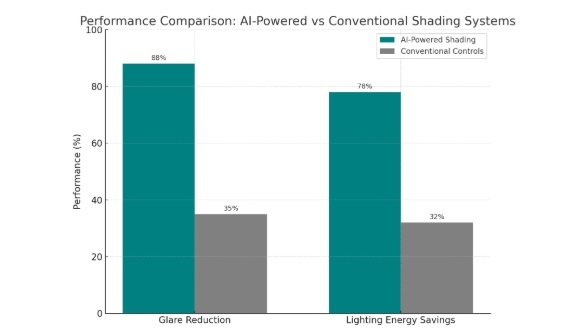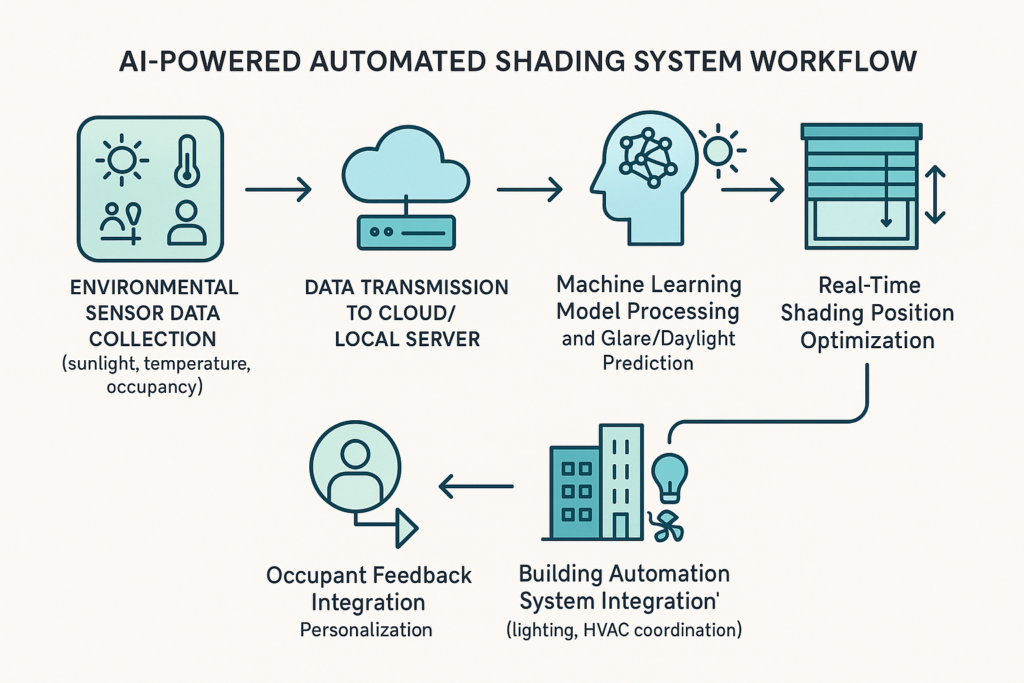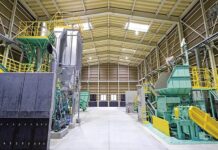Introduction
AI Automated shading systems have come a long way from basic manual or timer-based blinds to advanced smart shading solutions that adapt dynamically to environmental conditions. The application of artificial intelligence (AI) and machine learning (ML) is now revolutionizing these systems into intelligent beings that can optimize light, thermal comfort, energy efficiency, and occupant well-being at the same time. This article discusses how AI and ML are powering next-generation automated shading systems, uncovering their influence on industry, technology, market development, and potential future.
“AI-driven shading systems transform passive building elements into active participants in energy management and occupant well-being.” — Industry expert commentary from Mado Dynamic press release, 2025
Industry Context and Market Overview
The market for AI automated shading systems has seen remarkable growth in recent years, spurred by growing concern for sustainability in building design, increasing energy prices, and developing smart home technologies. Based on market research statistics, the worldwide automated shading system market was worth more than $19 billion in 2023 and is expected to grow to more than $41 billion by 2032, which indicates a compound annual growth rate (CAGR) of approximately 9-10%. This growth is not only driven by commercial building but also by increasing demand in residential markets, driven by consumer demand for enhanced comfort and energy efficiency.
Demand is also supported by regulatory changes focusing on developing energy efficiency and green building certifications, in which shading systems are critical in controlling solar heat gain and daylight harvesting. Increased smart building ecosystems and Internet of Things (IoT) connectivity have made shading systems integrate directly with lighting, HVAC, and security systems, further enhancing their value as energy and comfort maximization tools.
Recent Developments and Trends
Recent years have seen several key trends in AI automated shading, including:
- Integration of AI and ML for Predictive Control: Beyond basic sensor-activated or time-based controls, AI algorithms use past information, current sensor readings, and weather forecasts to anticipate and adjust shading positions in advance to maximize occupant comfort and energy consumption.
- Multi-Zone and Personalized Control: Modern systems now accommodate sophisticated spaces like open-plan office environments, where occupancy is spatially and temporally varied. Machine learning algorithms can control multiple blinds independently depending on occupant location, preference, and ambient conditions.
- Energy Harvesting and Solar-Powered Systems: Advances in solar-powered motors and wireless battery technologies provide shading solutions that are simpler to retrofit and renewable.
- Voice and App Integration: Advanced AI automated shading offers seamless user control through voice commands, smartphone applications, and integration with smart home assistants.
- Privacy and Visual Comfort Prioritization: Cutting-edge algorithms focus on minimising glare while maximising natural daylight intake, all without the use of intrusive cameras, thereby safeguarding privacy and enhancing visual comfort.
For example, Mado Dynamic unveiled AI-driven, energy-efficient dynamic window shades that integrate solar-powered motors and smart automation, targeting residential markets seeking sustainability combined with affordability.
Technology and Innovation Insights
Artificial intelligence and machine learning underpin the intelligence of modern automated shading systems across multiple dimensions:
Predictive Glare and Daylight Modeling
Conventional shading control strategies traditionally depended on basic metrics like indoor illuminance or solar orientation, whereas AI-based solutions employ sophisticated data-driven models that more reliably predict glare and daylight situations. Pre-simulated daylight data-trained machine learning classification models with real-time solar irradiance inputs are able to predict glare probability and modulate slat angles accordingly, providing better visual comfort performance than traditional cut-off angle approaches. This method avoids redundant shading and allows maximum daylight penetration.
Surrogate Modeling and Real-Time Optimization
Machine learning surrogate models are rapid approximations of computationally expensive daylight simulations. By incorporating these models into shading controllers, buildings can dynamically optimize vertical eye illuminance and solar heat gains for many occupied spaces. This multi-objective optimization balances energy savings, glare control, and occupant comfort, producing outcomes impossible with manual or sensor controls.
Integration with Building Automation and IoT
Automated shading products increasingly link into building automation systems (BAS), lighting, HVAC, and environmental sensors. AI programs sift through rich data streams—occupancy habits, weather predictions, internal temperatures—to coordinate shading with other building operations, enhancing energy efficiency as a whole. Cloud-based analytics platforms are offered by some manufacturers to support ongoing learning and system fine-tuning.
“The integration of machine learning into dynamic shading control offers a breakthrough in balancing visual comfort and energy efficiency, particularly in complex office environments.” — Paraphrased from research by Luo et al., 2021
Privacy-Preserving Sensing
To resolve privacy issues related to cameras or visual sensors, AI methods are utilized to reduce intrusive sensing demands. For example, models that utilize only outdoor environmental sensors or anonymized data streams can still make accurate glare and daylight predictions without compromising occupant privacy or system performance.
Hardware Advances
Next-generation motorized shades have quieter, more dependable motors with smaller light gaps, allowing for improved shading accuracy and appearance. Wireless solar-powered solutions make installation and power management easier, opening up the market for AI shading to retrofit and residential applications.
Key Players and Stakeholders
The AI automated shading industry includes established manufacturers, new tech innovators, research institutions, and software developers:
- Manufacturers: Firms such as Hunter Douglas, MechoShade, Screen Innovations (its Zen 2 system), and Rollease Acmeda offer state-of-the-art motorized shading products that include AI-powered automation platforms.
- Tech Innovators: Firms such as Mado Dynamic are leading the development of AI-based dynamic shading with solar motor drives, aimed at residential use through Kickstarter launches and retail introductions.
- Research Institutions: University and lab researchers work on early-stage research in AI-powered glare control and daylight modeling, driving surrogate modeling and optimization algorithms.
- System Integrators: Intelligent building integrators and BAS providers integrate AI shading solutions as part of robust energy management and occupant comfort systems.
- Standardization Bodies and Regulators: Organizations advance energy efficiency standards and green building certifications that highlight the importance of smart shading.
Data and Forecasts
Market reports forecast the AI automated shading industry will expand well, with CAGR forecasts between 9-10% over 2030+. The role of smart shading in energy saving is amply substantiated by field and simulation reports. For instance, it has been found that AI-based shading policies can minimize glare by more than 85% and reduce lighting energy consumption by approximately 80%, far surpassing conventional control methods.
Vertical eye illuminance (Ev) optimization and daylight glare probability (DGP) prediction through machine learning have demonstrated potential in open-plan office case studies to achieve significant occupant comfort improvements and energy savings. These data-driven systems promote a transition from reactive to proactive shading control.
Challenges and Opportunities
Despite progress, challenges remain in AI-powered automated shading:
- Customization and Scalability: The distinct architecture, orientation, and occupant patterns of each building require custom AI models, which involve significant simulation and training effort that can constrain scalability.
- Computational Complexity and Data Integration: Real-time optimization of multiple objectives requires computational efficiency and integration across sensor types and building systems.
- User Acceptance: Diverse occupant preferences and potential overrides require adaptive learning and personalization features.
- Cost and Installation Complexity: Technological advancements in wireless and solar-powered hardware assist, but initial costs and retrofitting difficulties can deter adoption.
Opportunities exist in creating more generic AI models, enhancing user interfaces, and integrating shading more thoroughly into building systems. Increasing focus on sustainability and occupant well-being will stimulate innovation and investment.
Future Outlook
The future of automated shading systems holds greater AI integration, making them genuinely intelligent, adaptive, and user-friendly shading ecosystems. Machine learning algorithm advancements, sensor technology, and cloud computing will facilitate fast installation, real-time optimization, and customized comfort control.
We expect shading systems to be standard features of smart buildings, effortlessly integrating with lighting, HVAC, and security for integrated energy and comfort optimization. Green building codes and regulatory standards will further require intelligent shading solutions.
Furthermore, the widespread adoption of AI-powered shading in the residential markets will democratize access to energy-saving and comfort-enhancing technology, facilitated by wireless, solar-powered hardware in conjunction with intuitive voice and app control.
As one industry expert observed, “AI and machine learning are revolutionizing automated shading by enabling predictive, occupant-centric control that balances daylight, glare, and energy use with unprecedented precision. The days of static shading are numbered.”
Market Size and CAGR of Automated Shading Systems (2023–2032)
| Year | Market Size (USD Billion) | CAGR (%) |
| 2023 | 19.7 | – |
| 2025 | ~23.5 | ~9 |
| 2030 | ~35 | ~9 |
| 2032 | 41.66 | ~9 |
Energy Savings Comparison of AI-Powered vs Conventional Shading Controls

AI-Powered Automated Shading System Workflow

Conclusion
Artificial intelligence and machine learning are driving a revolution in automated shading systems, introducing a new era of smart, predictive, and occupant-centric shading controls. These technologies enable building environments to maximize the use of natural light, reduce glare, minimize energy consumption, and create greater indoor comfort than ever before.
Though customization challenges, computational requirements, and user acceptance remain, the steady advances in surrogate modeling, sensor integration, and hardware design hold out for scalable and cost-effective solutions. The strong growth curve of the automated shading market indicates the growing appreciation of shading as not only a comfort appliance but as a critical element of sustainable, intelligent buildings.
The future is towards universal adoption of AI-driven automated shading systems that blend with building automation and smart home environments, providing real-world value for energy efficiency, occupant health, and architectural beauty. As the systems continue to mature, they will become an essential part of buildings of the future.





























